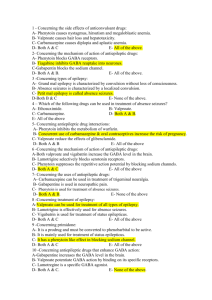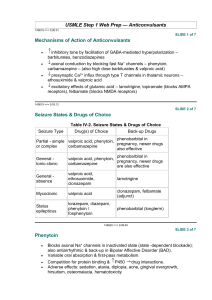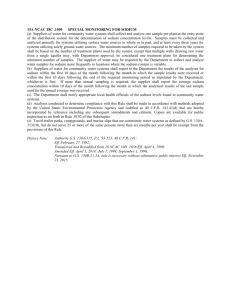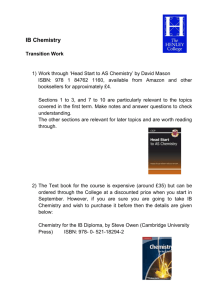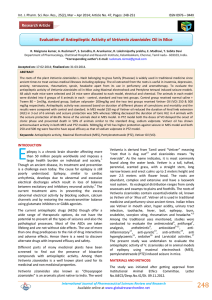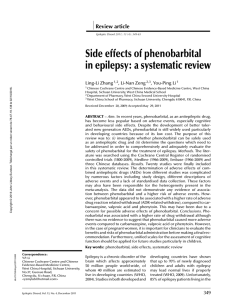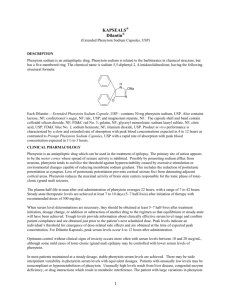中国协和医科大学 - 中国医学科学院&北京协和医学院精品课程建设
advertisement
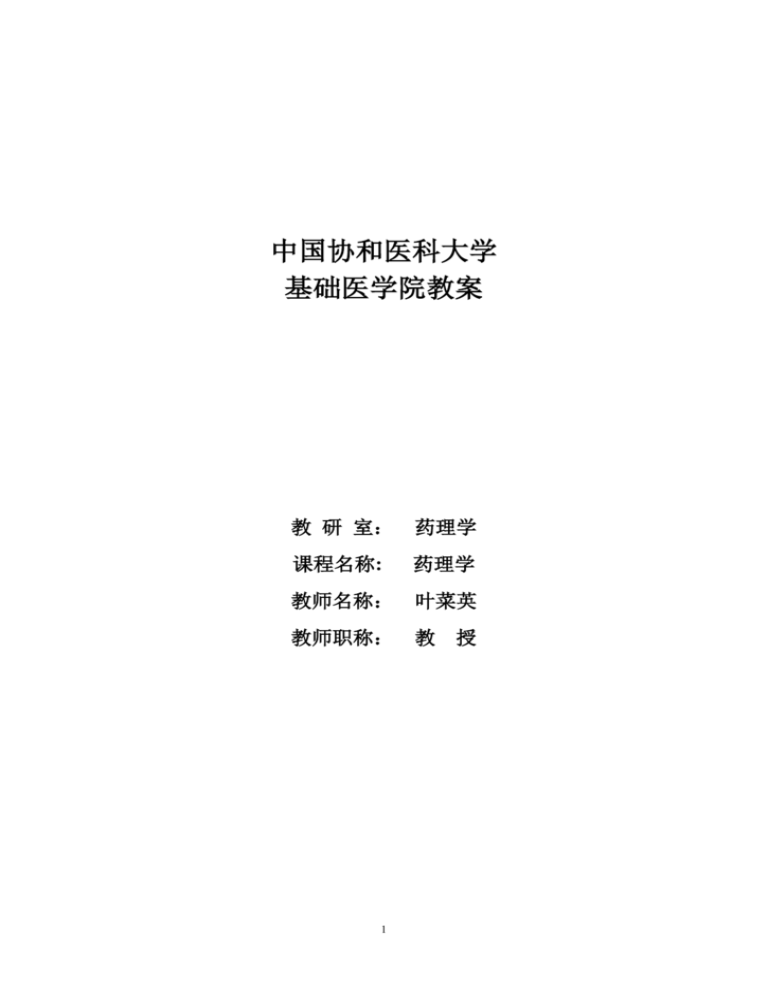
中国协和医科大学 基础医学院教案 教 研 室: 药理学 课程名称: 药理学 教师名称: 叶菜英 教师职称: 教 1 授 Teaching topic: Teaching subjects: Hours: Antiepileptic Drugs Teaching aims: Teaching content: Understand the classification and pathogenesis of epilepsy Medical Students 1.5 class hours Grasp the pharmacologic effect, mechanism of action, clinical application and adverse effects of Sodium Phenytoin and Phenobarbital. Grasp the pharmacologic properties and adverse effects of Ethosuximide, Sodium Valproate, Carbamzepine and Benzodiazepines. Key Points: Antiepileptic Drugs and Anticonvulsant Drugs Difficult Points: Pharmacologic effect and clinical application of Sodium Phenytoin and Phenobarbital Evaluation methods Mechanism of action of Sodium Phenytoin and Phenobarbital References Student Assessment 1.Rang and Dale’s Pharmacology 6th edition Rang HP, Dall MM, Ritter JM, Flower RJ , Churchill Livingstong, Elsevier, 2007 2.Golan DE, et al. Principle of Pharmacology, The pathophysiologic basis of drug therepy 2nd ed. 2008 3.Farrell SE, Priciples of Pharmacology, Workbook 2nd ed, 2008 Lippincott. 4.Finlel R.,et al. eds, Lippincott’s Illustrated Reviews: Pharmacology 4th ed. Lippincott 2009 5. 杨世杰主编《药理学》 (8 年制规划教材) ,人民卫生出版社,2005 年 6. 张德昌主编《医学药理学》中国协和医科大学出版社 1998 年 2 Teaching aims Contents Methods Timeassignment Antiepileptic Drugs and Anticonvulsant 10 min Ⅰ. Definitions in epilepsy Comprehend Ⅱ. Common seizure types of Epilepsy 1. grand mal 2. petit mal 3. complex partial seizures 4. simple partial seizures Ⅲ. Pathogenesis of Epilepsy Ⅳ. Therapeutic principle Master Ⅴ. Classification of Antiepileptic Drugs 1. Hydantoins: Sodium Phenytoin 2.Barbiturates: Phenobarbital, Primidone 3.Succinimide: Ethosuximide 4.Benzodiazepine: Diazepam, Nitrazepam 5.Others: Sodium Valproate Media mix, explanation, question-rai sing and discussion Master Ⅵ. Physiological disposition, Mechanism of action, clinical application and Adverse effects of Sodium Phenytoin 20 min Master Ⅶ. Pharmacologic properties and Adverse effects of Phenobarbital, Primidone 10 min Ⅷ. Pharmacologic properties of Other Antiepileptic Drugs such as Ethosuximide, Diazepem, Nitrazepem, Sodium Valproate and Carbamzepine 10 min Ⅸ.Principle of Medication 5 min Ⅹ. Anticonvulsant Drugs 5 min Master Familiarity Reflection questions 1. 2. Classification of Antiepileptic Drugs Pharmacologic properties of Antiepileptic Drugs 3 Rema rks References 1. Rang and Dale’s Pharmacology 6th edition Rang HP, Dall MM, Ritter JM, Flower RJ , Churchill Livingstong, Elsevier, 2007 2. Golan DE, et al. Principle of Pharmacology, The pathophysiologic basis of drug therepy 2nd ed. 2008 3. Farrell SE, Priciples of Pharmacology, Workbook 2nd ed, 2008 Lippincott. 4. Finlel R.,et al. eds, Lippincott’s Illustrated Reviews: Pharmacology 4th ed. Lippincott 2009 5. 杨世杰主编《药理学》 (8 年制规划教材) ,人民卫生出版社,2005 年 6. 张德昌主编《医学药理学》中国协和医科大学出版社 1998 年 Antiepileptic Drugs I. Definitions in epilepsy Epilepsy comprises recurrent episodes of abnormal cerebral neuronal discharge. The resulting seizures are usually clinically obvious and vary in pattern according to which parts of the brain are affected. II. Common seizure types of Epilepsy Generalised seizures. Absence (petit mal). Tonic/clonic (grand mal). Partial seizures. Simple partial seizures. Complex partial seizures (temporal lobe epilepsy). III. Pathogenesis of Epilepsy The neuron in brain lesion depolarizes together suddenly, and then product high-frequency out-break discharge. The discharge can diffuse to surrounding normal tissue →extensive excitation →the brain function transient aberration. IV. Therapeutic principle Change the permeability of Na+, Ca2+and K+ in nerve cell membrane, degrade excitement stage, extend refractory phase. Directly or indirectly increase CNS levels of GABA. V. Classification of Antiepileptic Drugs Hydantoins:Sodium Phenytoin Barbiturates:Phenobarbital, Primidone Succinimide:Ethosuximide Benzodiazepine: Diazepam, Nitrazepam Others: Sodium Valproate 4 VI. Sodium Phenytoin Physiological disposition Sodium Phenytoin is absorbed slowly after oral administration.→After 6-10 days, its plasma concentration can achieve effect levels. This drug has variable interpatient plasma concentration. Mechanism of action ① It can block sodium channels (voltage-, frequency-, and time dependent fashion) and inhibit the generation of action potentials. ② It can increase the function of inhibitory transmitter GABA, inhibit nerve terminal to uptake GABA and induce the increasing of GABA receptor, thereby enhance GABA-mediated postsynaptic inhibition. Pharmacologic properties and Clinical application Anti-epileptic:It can be used for partial seizures and tonic/clonic seizures, but not for other generalised seizure types. Peripheral neuralgia:cranial nerve, ischiadic nerve and cranial nerve. Arrhythmia : membrane-stabilizing action. Adverse effects Digestive system Gingival hyperplasia Nervous system Hematological system Skeletal system Allergic response Others VII. Phenobarbital Mechanism of action a. Phenobarbital can inhibit the paradoxical discharge of epilepsy focus selectively, enhance stimulation of surrounding tissues and block discharge diffuse to normal tissues. b. Phenobarbital facilitate GABA-mediated inhibition of neuronal activity. Pharmacologic properties Phenobarbital can be used for all types of epilepsy. The effects by turns are: grand mal and status epileptics>local psychomotor seizure>petit mal. 5 Take effect rapidly(1~2 hr), the first choice of grand mal. Prevent convulsive and eliminate precursory symptom. Adverse effects Somnolence、depression. Tolerance develops after long-term treatment. VIII. Other Antiepileptic Drugs such as Primidone, Ethosuximide, Diazepem, Nitrazepem, Sodium Valproate and Carbamzepine IX. Principle of Medication 1~2 times/year,no drugs are needed Grand pit (first choice): Sodium phenytoin or phenobarbital, carbamzepine, Primidone. Petit mal (first choice): Ethosuximide, clonazepam and sodium valproate. Status epilepticus:Diazepam or sodium phenytoin (IV), phenobarbital, diazepam, clonazepam. Psychomotor: Sodium phenytoin or combine with desoxybarbital or carbamazepine. X. Anticonvulsant Drugs Convulsions are involuntary skeletal muscular contractions. Convulsions can arise from pathological processes within or outside the brain, toxins, drug overdose, or withdrawal from drug dependence. Commonly used anticonvulsant drugs are sedative and hypnotic drugs. Magnesium Sulfate is also used on this disease. 6
